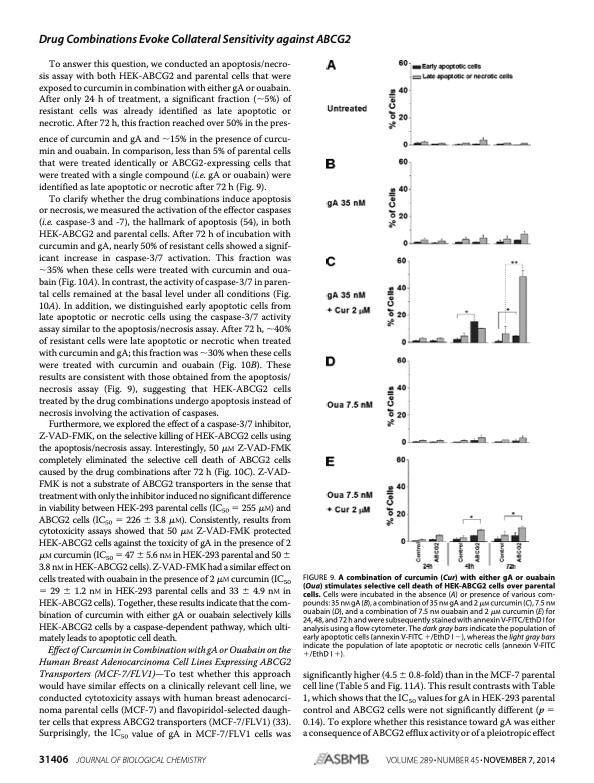
PDF Publication Title:
Text from PDF Page: 010
Drug Combinations Evoke Collateral Sensitivity against ABCG2 To answer this question, we conducted an apoptosis/necro- sis assay with both HEK-ABCG2 and parental cells that were exposed to curcumin in combination with either gA or ouabain. After only 24 h of treatment, a significant fraction (5%) of resistant cells was already identified as late apoptotic or necrotic. After 72 h, this fraction reached over 50% in the pres- ence of curcumin and gA and 15% in the presence of curcu- min and ouabain. In comparison, less than 5% of parental cells that were treated identically or ABCG2-expressing cells that were treated with a single compound (i.e. gA or ouabain) were identified as late apoptotic or necrotic after 72 h (Fig. 9). To clarify whether the drug combinations induce apoptosis or necrosis, we measured the activation of the effector caspases (i.e. caspase-3 and -7), the hallmark of apoptosis (54), in both HEK-ABCG2 and parental cells. After 72 h of incubation with curcumin and gA, nearly 50% of resistant cells showed a signif- icant increase in caspase-3/7 activation. This fraction was 35% when these cells were treated with curcumin and oua- bain (Fig. 10A). In contrast, the activity of caspase-3/7 in paren- tal cells remained at the basal level under all conditions (Fig. 10A). In addition, we distinguished early apoptotic cells from late apoptotic or necrotic cells using the caspase-3/7 activity assay similar to the apoptosis/necrosis assay. After 72 h, 40% of resistant cells were late apoptotic or necrotic when treated with curcumin and gA; this fraction was 30% when these cells were treated with curcumin and ouabain (Fig. 10B). These results are consistent with those obtained from the apoptosis/ necrosis assay (Fig. 9), suggesting that HEK-ABCG2 cells treated by the drug combinations undergo apoptosis instead of necrosis involving the activation of caspases. Furthermore, we explored the effect of a caspase-3/7 inhibitor, Z-VAD-FMK, on the selective killing of HEK-ABCG2 cells using the apoptosis/necrosis assay. Interestingly, 50 M Z-VAD-FMK completely eliminated the selective cell death of ABCG2 cells caused by the drug combinations after 72 h (Fig. 10C). Z-VAD- FMK is not a substrate of ABCG2 transporters in the sense that treatment with only the inhibitor induced no significant difference in viability between HEK-293 parental cells (IC50 255 M) and ABCG2 cells (IC50 226 3.8 M). Consistently, results from cytotoxicity assays showed that 50 M Z-VAD-FMK protected HEK-ABCG2 cells against the toxicity of gA in the presence of 2 M curcumin (IC50 47 5.6 nM in HEK-293 parental and 50 3.8 nM in HEK-ABCG2 cells). Z-VAD-FMK had a similar effect on cells treated with ouabain in the presence of 2 M curcumin (IC50 29 1.2 nM in HEK-293 parental cells and 33 4.9 nM in HEK-ABCG2 cells). Together, these results indicate that the com- bination of curcumin with either gA or ouabain selectively kills HEK-ABCG2 cells by a caspase-dependent pathway, which ulti- mately leads to apoptotic cell death. Effect of Curcumin in Combination with gA or Ouabain on the Human Breast Adenocarcinoma Cell Lines Expressing ABCG2 Transporters (MCF-7/FLV1)—To test whether this approach would have similar effects on a clinically relevant cell line, we conducted cytotoxicity assays with human breast adenocarci- noma parental cells (MCF-7) and flavopiridol-selected daugh- ter cells that express ABCG2 transporters (MCF-7/FLV1) (33). Surprisingly, the IC50 value of gA in MCF-7/FLV1 cells was FIGURE 9. A combination of curcumin (Cur) with either gA or ouabain (Oua) stimulates selective cell death of HEK-ABCG2 cells over parental cells. Cells were incubated in the absence (A) or presence of various com- pounds: 35 nM gA (B), a combination of 35 nM gA and 2 M curcumin (C), 7.5 nM ouabain (D), and a combination of 7.5 nM ouabain and 2 M curcumin (E) for 24, 48, and 72 h and were subsequently stained with annexin V-FITC/EthD I for analysis using a flow cytometer. The dark gray bars indicate the population of early apoptotic cells (annexin V-FITC /EthD I ), whereas the light gray bars indicate the population of late apoptotic or necrotic cells (annexin V-FITC /EthD I ). significantly higher (4.5 0.8-fold) than in the MCF-7 parental cell line (Table 5 and Fig. 11A). This result contrasts with Table 1, which shows that the IC50 values for gA in HEK-293 parental control and ABCG2 cells were not significantly different (p 0.14). To explore whether this resistance toward gA was either a consequence of ABCG2 efflux activity or of a pleiotropic effect 31406 JOURNAL OF BIOLOGICAL CHEMISTRY VOLUME 289 • NUMBER 45 • NOVEMBER 7, 2014PDF Image | Curcumin with Either Gramicidin or Ouabain

PDF Search Title:
Curcumin with Either Gramicidin or OuabainOriginal File Name Searched:
PIIS0021925820333664.pdfDIY PDF Search: Google It | Yahoo | Bing
CO2 Organic Rankine Cycle Experimenter Platform The supercritical CO2 phase change system is both a heat pump and organic rankine cycle which can be used for those purposes and as a supercritical extractor for advanced subcritical and supercritical extraction technology. Uses include producing nanoparticles, precious metal CO2 extraction, lithium battery recycling, and other applications... More Info
Heat Pumps CO2 ORC Heat Pump System Platform More Info
| CONTACT TEL: 608-238-6001 Email: greg@infinityturbine.com | RSS | AMP |